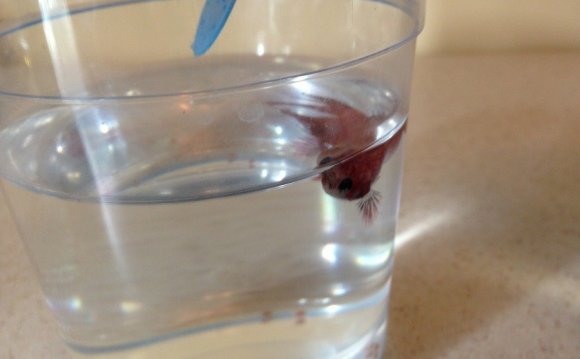
Swim Bladder Disorder (also called SBD, Swim Bladder Disease, or simply "swim bladder") is an extremely common disorder among bettas and other fish, particularly due to husbandry misconceptions. The swim bladder is an flexible-walled organ filled with gas, which controls the fish's buoyancy. Swim bladder disorder is a symptom rather than a disease in and of itself, but should be taken very seriously, as the conditions leading to it can be deadly if left untreated.
Symptoms
The betta is unable to swim properly, characterized by floating at the top, sinking to the bottom and/or listing sideways. The betta often looks like it takes it a great deal of work to swim to the bottom (if floating) or reach the surface (if sinking), and will pop back up like a cork or sink like a stone.
A constipated fish may look bloated (slightly or greatly), or seem to have difficulty passing feces (stringy, trailing, or exceptionally large poop).
Causes
The vast majority of the time, the cause is constipation. Constipation in bettas can be deadly if left untreated. Constipation causes the digestive tract to become enlarged and press on the swim bladder. Constipation is an extremely common condition.
Causes of Constipation
- Flake foods or freeze-dried foods. Both of these expand in the fish's stomach and cause constipation.
- Overfeeding. A betta's stomach is smaller than its eye.
- Temperature too low, slowing down the fish's metabolism, and therefore, digestive system. The temperature should be kept stable, at 76 - 80 degrees Fahrenheit.
- Extremely sensitive fish may become constipated despite the best diets and conditions.
In a relatively few cases, SBD may be caused by bacterial infections, parasites, or trauma (injury). Fish may be born with SBD, in which case it is a congenital defect. Congenital defects may contribute to a fish being particularly sensitive to constipation and having chronic or frequent SBD.
Treatment
When SBD is observed with no other symptoms or known causes, it is best to begin treatment for constipation. Most of the time, SBD will clear up immediately when the fish is no longer constipated.
- Keep the water super clean and warm (increase the temperature slowly, only a degree every couple hours, until it is around 80 degrees; keep the temperature stable).
- If possible, leave the tank's bottom bare (no gravel, rocks or marbles), so you can monitor the fish's feces. A hospital tank may be useful.
- Encourage the betta to flare by placing another betta's tank nearby, or showing the betta a mirror. Bettas often poo when they flare.
- Fast the fish for three days. No food at all.
- On the fourth day, feed the betta a blanched (frozen-thawed) pea. For bettas, as obligate carnivores, the pea consists mostly of undigestible fiber, which is wonderful for clearing out the digestive tract. Most bettas find peas extremely palatable! Take a frozen pea. Do not use fresh (risk of pesticides or other environmental toxins) or canned (too squishy and way too much salt).
Place the pea in some dechlorinated, conditioned water (or simply take some from your betta's tank) in a microwave-safe container. Microwave the pea for a few seconds (mine takes about 10 seconds, but ovens vary), until thawed.
Skin the pea by slitting the skin and squeezing out the two halves of pea. Discard the skin.
Take about a quarter of the pea, and chop it into super tiny pieces. Remember, bettas have tiny stomachs, and do not need more than about a quarter. Feed the tiny pieces to your betta. Most of them love it!
- Usually, the betta will have a bowel movement within a day of the pea treatment. If the betta does not poo or there is no improvement, repeat treatment (fast and pea).









